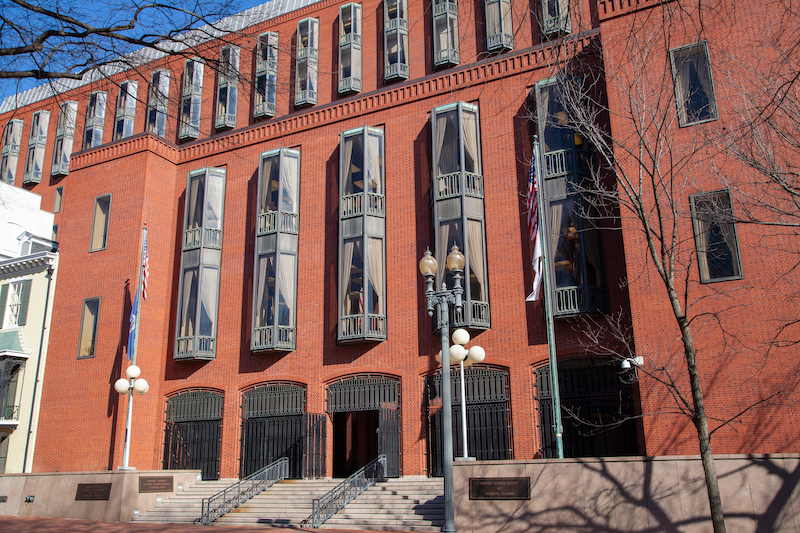“We agree with Qualcomm and the PTO that the ‘patents or printed publications’ that form the ‘basis’ of a ground for inter partes review must themselves be prior art to the challenged patent.” – CAFC
 The U.S. Court of Appeals for the Federal Circuit (CAFC) today vacated and remanded two decisions of the Patent Trial and Appeal Board (PTAB) on related inter partes reviews (IPRs) brought by Apple against Qualcomm, explaining that the Board’s determination that “prior art consisting of patents or printed publications” includes applicant admitted prior art (AAPA) was incorrect. The CAFC however remanded the case for the PTAB to decide “whether Apple’s petition nonetheless raises its § 103 challenge on the basis of prior art consisting of patents or printed publications.”
The U.S. Court of Appeals for the Federal Circuit (CAFC) today vacated and remanded two decisions of the Patent Trial and Appeal Board (PTAB) on related inter partes reviews (IPRs) brought by Apple against Qualcomm, explaining that the Board’s determination that “prior art consisting of patents or printed publications” includes applicant admitted prior art (AAPA) was incorrect. The CAFC however remanded the case for the PTAB to decide “whether Apple’s petition nonetheless raises its § 103 challenge on the basis of prior art consisting of patents or printed publications.”
Apple petitioned the PTAB to review the claims of U.S. Patent No. 8,063,674. In two separate decisions, the PTAB found several claims unpatentable under Section 103, basing its finding on a ground raised by Apple that relied in part on AAPA and a prior art patent. Apple also challenged the claims as unpatentable under Section 103 based on two prior patents and one publication, but the Board said that Apple had not proven unpatentability on this ground.
Qualcomm argued on appeal that the PTAB could not rely on AAPA under 35 U.S.C. § 311(b), which says that “A petitioner in an inter partes review may request to cancel as unpatentable 1 or more claims of a patent only on a ground that could be raised under section 102 or 103 and only on the basis of prior art consisting of patents or printed publications.”
In its ruling, the PTAB stated: “Because AAPA is admitted to be prior art and is found in the ’674 patent, it can be used to challenge the claims in an inter partes review.” The Board also said that “prior art consisting of patents or printed publications” includes AAPA because it is prior art contained in a patent. The Federal Circuit disagreed. The court explained:
We agree with Qualcomm and the PTO that the “patents or printed publications” that form the “basis” of a ground for inter partes review must themselves be prior art to the challenged patent. That conclusion excludes any descriptions of the prior art contained in the challenged patent. This interpretation is consistent with prior judicial interpretations of the statute and represents a more natural reading of § 311(b).
The U.S. Patent and Trademark Office (USPTO) had asked the CAFC to remand the case so the Board could apply the Director’s guidance on the “Treatment of Statements of the Applicant in the Challenged Patent in Inter Partes Reviews Under § 311(b)” (Guidance). The Guidance agrees with Qualcomm that AAPA does not fall within “prior art consisting of patents or printed publications” under § 311(b), but reads CAFC caselaw to permit the use of AAPA in IPR as evidence of the general knowledge of a skilled artisan.
The CAFC, despite its above holding, likewise noted that AAPA is still not “categorically excluded” from an IPR. Citing Koninklijke Philips N.V. v. Google LLC, 948 F.3d 1330, 1339 (Fed. Cir. 2020) (citing PharmaStem Therapeutics, Inc. v. ViaCell, Inc., 491 F.3d 1342, 1362 (Fed. Cir. 2007), the court noted that it has previously held “‘it is appropriate to rely on admissions in a patent’s specification when assessing whether that patent’s claims would have been obvious’ in an inter partes review proceeding.” This is because, like expert testimony and party admissions, AAPA can help to “establish the background knowledge possessed by a person of ordinary skill in the art.”
Because the Board did not address the question of whether AAPA improperly formed the “basis” of Apple’s challenge, the court remanded the case to the PTAB for that purpose.
The CAFC also rejected Apple’s alternative ground for affirmance of the PTAB’s decisions based on the prior patents and publication, finding that the Board did not abuse its discretion in determining that Apple’s proposed motivation to combine two of the references was untimely raised for the first time on reply.

![[IPWatchdog Logo]](https://ipwatchdog.com/wp-content/themes/IPWatchdog%20-%202023/assets/images/temp/logo-small@2x.png)

![[Advertisement]](https://ipwatchdog.com/wp-content/uploads/2024/04/UnitedLex-May-2-2024-sidebar-700x500-1.jpg)
![[Advertisement]](https://ipwatchdog.com/wp-content/uploads/2024/04/Artificial-Intelligence-2024-REPLAY-sidebar-700x500-corrected.jpg)
![[Advertisement]](https://ipwatchdog.com/wp-content/uploads/2024/04/Patent-Litigation-Masters-2024-sidebar-700x500-1.jpg)

![[Advertisement]](https://ipwatchdog.com/wp-content/uploads/2021/12/WEBINAR-336-x-280-px.png)
![[Advertisement]](https://ipwatchdog.com/wp-content/uploads/2021/12/2021-Patent-Practice-on-Demand-recorded-Feb-2021-336-x-280.jpg)
![[Advertisement]](https://ipwatchdog.com/wp-content/uploads/2021/12/Ad-4-The-Invent-Patent-System™.png)






Join the Discussion
2 comments so far.
Alan Burnett
February 2, 2022 01:47 pmThe oral argument for this case was interesting. Judge Chen was pushing Apple’s representative to see how much reliance could be placed on AAPA (apparently to address the basis issue), even suggesting a hypothetical where many (20) of the limitations are in the AAPA and only one limitation was in the prior art reference – is that OK? The court should have been clear that a prior art reference could be modified in view of AAPA but that AAPA could not be modified by the teachings in a prior art reference (since in this latter case the AAPA would be the basis of the rejection). Under the proposed ground, Apple modified a prior art diagram in the patent with circuitry from a prior art reference.
Anon
February 2, 2022 08:06 amIf nothing else, this “lesson” is one in Patent Profanity and (again) emphasizes that applicants MUST be extremely careful in any characterization of ANYTHING ELSE beyond the inventor’s work.
This is also confirmation as to WHY specifications are deliberately ‘threadbare’ (and have become much much much more so).
Tell a story in your application?
Certainly.
Feed the courts and competitors ammunition to attack your application in this manner (or perhaps relatedly, in a 103 attack by including “motivation” IN your “Background” section)?
Certainly NOT.